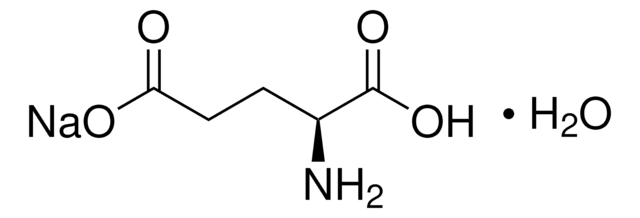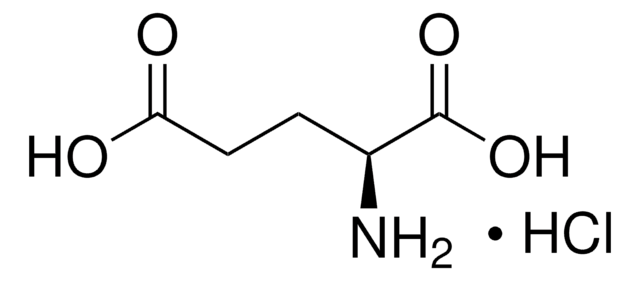G1251
L-Glutamic acid
≥99% (HPLC), suitable for microbiological culture, ReagentPlus®
Sinónimos:
(S)-2-Aminopentanedioic acid, Glu
About This Item
Productos recomendados
product name
L-Glutamic acid, ReagentPlus®, ≥99% (HPLC)
Agency
suitable for SM 5210
Nivel de calidad
Línea del producto
ReagentPlus®
Análisis
≥99% (HPLC)
formulario
powder
técnicas
microbiological culture: suitable
color
white to off-white
mp
205 °C (dec.) (lit.)
solubilidad
1 M HCl: soluble 100 mg/mL
densidad
1.54 g/cm3 at 20 °C
trazas de catión
C: 40.4-41.2%
N: 9.2-9.8%
cadena SMILES
N[C@@H](CCC(O)=O)C(O)=O
InChI
1S/C5H9NO4/c6-3(5(9)10)1-2-4(7)8/h3H,1-2,6H2,(H,7,8)(H,9,10)/t3-/m0/s1
Clave InChI
WHUUTDBJXJRKMK-VKHMYHEASA-N
Información sobre el gen
human ... CCR2(1231) , GRIA1(2890) , GRIA2(2891) , GRIA4(2893) , GRIK2(2898) , GRIK3(2899) , GRIK5(2901) , GRIN2B(2904) , GRM2(2912) , SLC1A1(6505) , SLC1A2(6506)
rat ... Gria1(50592) , Grik1(29559) , Grik2(54257) , Grik4(24406) , Grin2a(24409) , Grm1(24414) , Grm2(24415) , Grm3(24416) , Grm4(24417) , Grm5(24418) , Grm6(24419) , Grm7(81672) , Slc1a2(29482)
¿Está buscando productos similares? Visita Guía de comparación de productos
Categorías relacionadas
Aplicación
Acciones bioquímicas o fisiológicas
Glutamine serves as a source of energy for rapidly dividing cells comprising lymphocytes, enterocytes, macrophages and tumors. Glutamine mediates protein turnover via cellular mTOR (mammalian target of rapamycin) signaling. It is also known to be associated with the inhibition of apoptosis.
Información legal
Aplicación
Código de clase de almacenamiento
11 - Combustible Solids
Clase de riesgo para el agua (WGK)
WGK 1
Punto de inflamabilidad (°F)
Not applicable
Punto de inflamabilidad (°C)
Not applicable
Equipo de protección personal
Eyeshields, Gloves, type N95 (US)
Certificados de análisis (COA)
Busque Certificados de análisis (COA) introduciendo el número de lote del producto. Los números de lote se encuentran en la etiqueta del producto después de las palabras «Lot» o «Batch»
¿Ya tiene este producto?
Encuentre la documentación para los productos que ha comprado recientemente en la Biblioteca de documentos.
Los clientes también vieron
Chromatograms
application for HPLCNuestro equipo de científicos tiene experiencia en todas las áreas de investigación: Ciencias de la vida, Ciencia de los materiales, Síntesis química, Cromatografía, Analítica y muchas otras.
Póngase en contacto con el Servicio técnico







